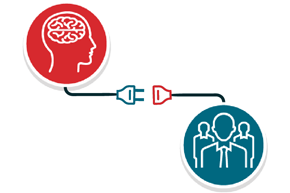
From the way you watch television programming to how medical communication and education is carried out, new technologies are evolving to enhance and reinvent how we live, learn, socialize, and conduct business. Hungry to further develop our client toolbox, at Vision2Voice we are continually learning about emerging technology components that will further enhance how we deliver the medical content we develop. Although some of these trends seem in the distant future, you might just be surprised when you see them transform how medical content is delivered at a speaker program or speaker training meeting.
Microsoft Hololens. Imagine a world where the human body is intelligently mapped and clinicians can fully interact with the body by pinning a hologram in a physical location as easily as you can place an object in a room. That world is here with Microsoft Hololens. This technology (see graphic) will significantly advance the way medical education will be conducted. Microsoft is currently summoning developers to seek out new ways to incorporate this technology into our lives. Yet tremendous amounts of medical content has already been created and billions of lines of code will be written for these holographic lenses during 2016. In this way, clinicians will soon be able to fully immerse themselves into an experience that will provide a depth of understanding unlike anything ever seen before in medical education. By interacting with holograms of body parts, diseases, broken bones, and virtually any biomedical process, healthcare professionals will be able to accelerate their knowledge in ways never before imagined.
4K/Ultra HD Content Delivered via Over-the-Top Technology (OTT). OTT is delivered directly from provider to viewer using an open Internet/broadband connection, independent of the viewer’s Internet Service Provider (ISP). It is a best effort, unmanaged method of content delivery via the Internet that suits providers who are primarily broadcasters rather than ISPs. In 2015, companies like CBS, Dish, Showtime, HBO, and we at Vision2Voice, all launched OTT offerings. We have been proudly delivering OTT in high definition (HD) which is a fantastic viewing experience, however, 4K can deliver four times as many pixels as 1080p. As a pioneer in producing live medical broadcasts streamed via OTT, we believe that 4K broadcasts of live medical content are on the horizon. The OTT industry is leaping into 4K content creation/distribution with gusto and is well ahead of pay-TV and broadcast competitors in this particular domain.
Augmented knowledge. We are living in an age of digital telepathy where information is sent directly to one another’s brains via the Internet. Scientists at the University of Southern California have been working on a cognitive neural prosthesis that can restore and enhance memory function. The purpose of this research is ultimately to help victims of stroke or traumatic brain injuries regain their cognitive abilities and motor function. In the more distant future, the hope for medical education is to install specific techniques for prescribing complicated therapies, less common surgical techniques, or provide a greater understanding of how a biotech product works in a patient so physicians can accurately explain to patients how prescribed therapies can effectively work together for their benefit.
Algorithmic personality detection. Some life insurance companies are attempting to assess your personality by looking at your magazine subscriptions or the photos you post to social media in order to predict your future financial transactions. This algorithmic personality detection suggests that, if we look at two people with the same professional and personal circumstances, the one with the higher GPA will be more likely to pay off a debt. In marketing pharmaceuticals, biologics, or medical devices, these algorithms may be used to determine the most accurate method of what makes a physician tick. Algorithmic personality detection may help us understand the best ways that physicians learn and therefore provide us with the most effective means of delivering medical education to influence physician prescribing behaviors.





